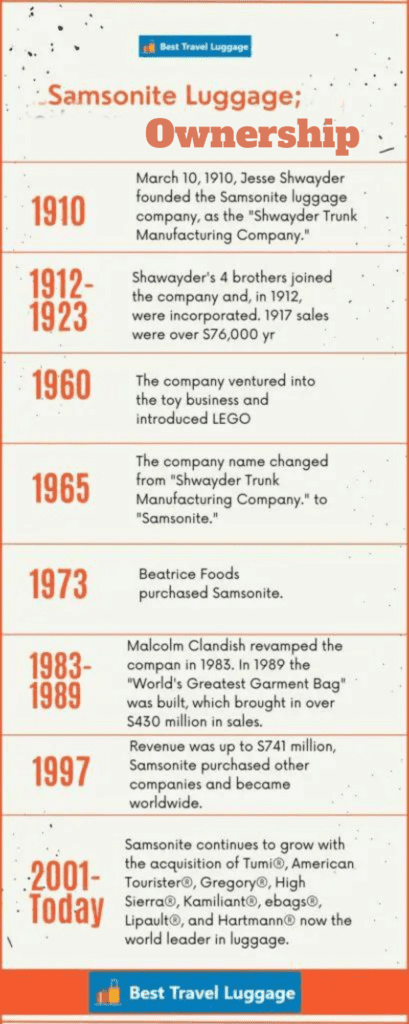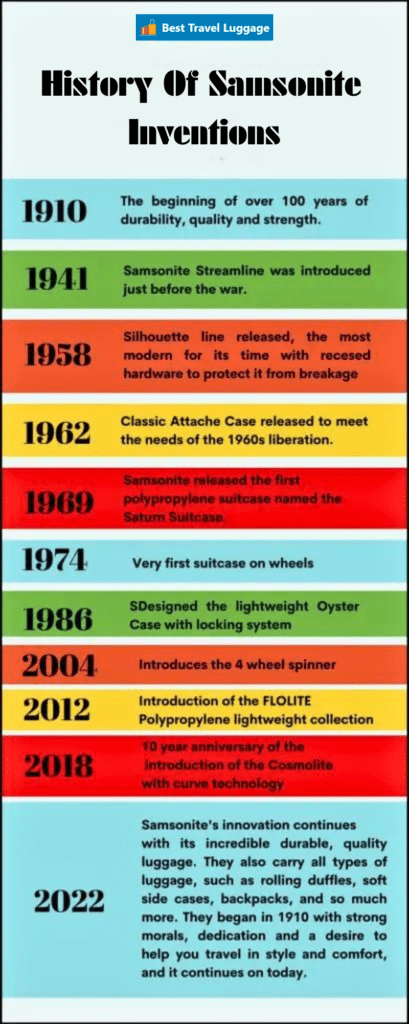Welcome, fellow luggage enthusiasts! “Samsonite Luggage History” speaks of a tale of innovation, resilience, and success that spans over a century.
The world of luggage is vast and varied, and understanding the roots of a leading brand like Samsonite can be a long and drawn-out task.
As a seasoned traveler, luggage lover, and fan of Samsonite, I’ve delved deep into the Samsonite luggage history. I’m here to share the fascinating journey of Samsonite, from its humble beginnings to its current status as a global leader.
Whether you’re a history buff, a Samsonite fan, or a casual reader, this article has something for you. Together, let’s walk down memory lane and explore Samsonite luggage history.
Jesse The Origin Of Samsonite Luggage
Jesse Shwayder (1882–1970) founded Samsonite luggage on March 10, 1910, in his Colorado home under the name “Shwayder Trunk Manufacturing Company.” Jesse was a strongly religious Jewish man who named pieces of his luggage after Samson from the bible. The luggage pieces called “Samsonite” sold so well that in 1965, the company changed its name to “Samsonite.”
Chronology Of Samsonite Luggage History


Brotherly Expansion
Four other Shwayder brothers joined Jesse in his luggage venture between 1912 and 1923. The first brother to join Jesse was Maurice, who traveled with Jesse to promote the luggage. By 1923, all four brothers were on board; Sol was the attorney, Mark was the sales force, and Ben and Maurice were in the manufacturing end of the business. Here in lies the beginning of Samsonite luggage history.
Ten-plus years into the luggage business, things were booming for the Shwayder brothers. The family home was no longer large enough to house their business, so they acquired a warehouse to manufacture their luggage.
Long after the death of Jesse Shwayder on July 25, 1970, the Shwayder family home was deemed a historic landmark, which took place on February 10, 2019.
Samsonite Principles
During the early days of Samsonite luggage, their competition was stiff. Many other luggage manufacturers had strong financial backing and monopolized the market.
Jesse was aware of this and developed his bags on the principles of durability, quality, and dependability. He didn’t attempt to undercut his competitor; instead, he charged more for his product based on better materials and strength. And it worked because just before the great depression of 1929, the company was booming.
How The Great Depression Influenced Samsonite Luggage History
The stock market crash of 1929 was an unfortunate twist for the Shwayder brothers. Their business suffered and nearly went under, but with their resistance and determination, they manufactured other things to stay afloat. At one time, they made card tables that outsold their luggage sales.
During the WW1 and WW2 in the 1940s and 1950s, the brothers used their factories to produce needed war materials. When that time ended, they resumed their production of innovative and durable luggage. With the Great Depression, Samsonite Luggage history could have been cut short if not for the tenacity of the Shwayder brothers
LEGO Toys Introduced Into Samsonite Luggage History
From 1960 to 1970, “Shwayder Trunk Manufacturing Company,” later known as “Samsonite,” began manufacturing the LEGO Samsonite toy and 50 + other new toys. Although this venture was a great hit, it did not do as well as their luggage, so in 1972, they stopped the manufacture of toys.
How The Company Name Change Affected Samsonite Luggage History
Because of Jesse’s religious background, he named a few of his luggage pieces Samsonite after the biblical person named Samson. In the bible, Samson is well known for his strength, and Jesse wanted to convey that strong character in his business and luggage.
In 1965, he changed the name of “Shwayder Trunk Manufacturing Company” to Samsonite to reflect the strength and durability of his product. The Samsonite name has carried the Samsonite luggage history into today.
The First Purchase Of Samsonite
During the great merger and acquisition period of the 1970s, Beatrice Foods purchased Samsonite in 1973. Samsonite was to operate independently but under the umbrella of Beatrice Foods. Although this merger was supposed to benefit Samsonite, the company began to suffer, and it appeared that Samsonite luggage history was coming to a close.
But, in 1983, Beatrice took control of the acquisition and employed Malcom Candlish to rebuild Samsonite into the giant it was. Malcolm did just that with his experience and reputation in the industry he moved the history of Samsonite luggage forward.
Malcom revamped the company from the ground up, laying off employees and rehiring a whole new workforce. He studied and surveyed what the world wanted in luggage, produced “the world’s greatest garment bag,” and put Samsonite back on the map. With the help of Clandlish, Samsonite was bringing in over $300 million in revenue by the end of 1986.
Samsonite’s Success Through The Years
By 1995 Samsonite was again an independent company. By 1997, Samsonite was pulling in over $741 million. Their innovative ideas and strong attention to durability and quality paid off, but not without some problems along the way.
New leaders were introduced to the company over the years to revamp and restructure the world of luggage. Samsonite luggage history continued as the most influential luggage company of all time. Samsonite began its own acquisitions of other luggage companies and has continued to thrive.
FAQ Section: Samsonite Luggage History
Samsonite is a name synonymous with quality luggage. Over the years, this brand has become a staple for travelers around the world. For those curious about the legacy of Samsonite luggage, we’ve compiled a list of frequently asked questions to shed light on the rich Samsonite history.
When was Samsonite first established?
Jesse Shwayder began Samsonite in Denver, Colorado in 1910. Originally, the company was named the Shwayder Trunk Manufacturing Company. It wasn’t until 1941 that one of its products was named “Samsonite,” after the biblical strongman Samson, reflecting the durability of their products.
How did Samsonite revolutionize the luggage industry?
In the 1960s, they introduced the first-ever polypropylene suitcase, which was lighter and more durable than traditional materials. This innovation set the standard for modern luggage and showcased Samsonite’s commitment to quality and innovation.
What makes Samsonite luggage stand out from its competitors?
Samsonite luggage is renowned for its durability, innovative design, and quality craftsmanship. They consistently kept up with technology by engineering new materials and designs. Their commitment to excellence and a century-long legacy has solidified their reputation as one of the leading luggage brands globally.
What is the Samsonite logo history?
The Samsonite logo history dates back to 1910 when Jesse Shwayder founded the company. The logo has evolved over the years, incorporating elements like the iconic Samsonite name and the silhouette of a traveler pulling a suitcase. Today, it represents Samsonite’s legacy of quality and innovation in the travel industry.
Additional Resources
If you are looking for more tutorials, walkthroughs, and troubleshooting on luggage, here are some additional posts about luggage:
Conclusion
Samsonite is the world leader in luggage production and innovation today. One person, Jesse Shwayder, wanted to start a business and, with the help of his 4 brothers, turned it into an icon.
It wasn’t without problems or an overnight success. It was the result of hard work, strong morals, and keeping up with consumer demands. Not only is Samsonite an incredible company, but so are you, the consumer. You helped them grow over 100 years to become what they are today.
Happy travels, my friends.
